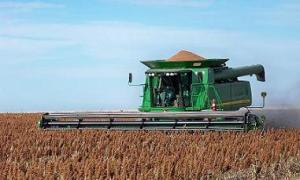Thirty-three percent of the U.S. corn crop has been harvested so far this year, compared to a five-year average of 32 percent, according to USDA’s Crop Progress Report, indicating the harvest is right on schedule. Corn condition for the 18 states surveyed, representing 94 percent of the U.S. corn crop, is reported at 53 percent in the good to excellent range.
Nebraska reported 19 percent harvested compared to the 20 percent five-year average. This trend is also seen in other states including Illinois, with 49 percent harvested compared to the 46 percent five-year average, and South Dakota, with 18 percent harvested compared to just 14 percent harvested five-year average.
According to U.S. Grains Council At-Large Director Alan Tiemann, a corn farmer in Seward, Neb., “The crop in Nebraska is looking good. A rainy past few days has slowed progress a bit but overall yields are good and moisture is about where you want it to be, around 15 percent. Quality is looking good and I’m anxious to get back out as soon as the field dries.�
News is bleak for Texas sorghum farmers in the panhandle, however, with only 50 percent of planted acres deemed worthy of harvest.
“Of my 25 years of farming, I’ve never experienced a year like this,� said Troy Skarke, USGC sorghum sector director and corn and sorghum farmer in Claude, Texas.
Skarke reported the average annual rainfall in Amarillo is 19.5 inches. This year’s rainfall totaled 3.78 inches thus far.
“Shortage of rain, constant 30 mile-per-hour winds and 40-50 days of consecutive 100 degree heat was devastating to this year’s corn and sorghum crops. The old timers compare this drought to that in the ‘50s where they received nine inches of rain for three consecutive years. This year we had a little more than three inches,� he said.
Skarke reported the Valley and Coastal regions of Texas experienced an above average crop. That, combined with Central Texas having an average crop will help to offset the loss in the Panhandle, he said.
“While we’ve heard of decreases in sorghum harvest around the nation, overall the crop won’t be tremendously reduced. Availability will be limited, however,� he said.
Of the 11 states surveyed, which represent 99 percent of the planted acres, the harvest is reported at 37 percent compared to the 43 percent five-year average, with 60 percent being in good to excellent condition.


